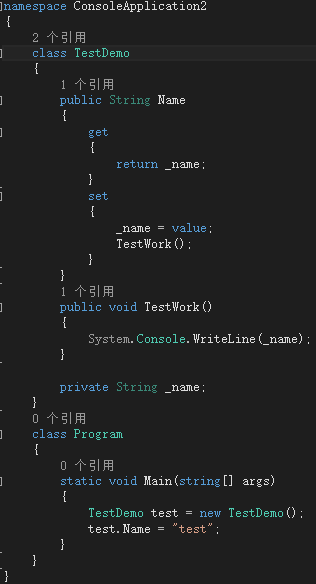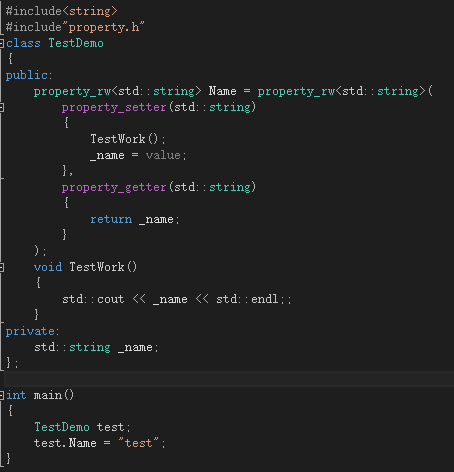目录(原创博客,版权所有,转载请注明出处 http://www.cnblogs.com/feng-sc)
2.2、C++实现效果与C#效果对比(熟悉C#属性读者可从此小节开始)
3.1、property_rw介绍
3.2、property_r、property_w介绍
1、概述
在程序员的行业里,有一个有趣的说法,但我觉得这个说法在其他行业也同样适用:行业的一流高手都在制定标准和概念,二流高手都在实现标准和概念,三流高手的都在使用标准。
我们今天来做一次二流的高手做的事情:1、为c++引入一个概念标准;2、用c++实现这个概念。
2、C#属性的概念
本想略过对C#属性的介绍,但考虑到读者可能没使用过C#,也不知道C#的属性到底有什么用,因此还是稍微从使用的角度先解释一下C#中属性的概念(如果您对属性已经足够了解,可直接跳过本章或直接从下面第2点的“C++实现效果与C#效果对比”开始)。
一下内容包含如下部分:
1、简单示例代码介绍C#中的属性;
2、C++实现效果与C#效果对比;
1、简单示例代码介绍C#中的属性
我们来看第一段C#代码:
//示例代码1.0 http://www.cnblogs.com/feng-sc/p/5742689.html
class TestDemo { public String Name { get; set; } } class Program { static void Main(string[] args) { TestDemo test = new TestDemo(); test.Name = "test"; System.Console.WriteLine(test.Name); } }
上面代码中,我们创建了一个String类型的属性Name,这个时候我们,我们的属性其实跟一个成员变量没啥区别,只是一个成员变量罢了。
另外,还需要读者了解的是,属性里的get和set分别控制属性的读写权限:
1、如果只有get,那么Name为只读模式;
2、如果只有set,那么Name为只写模式;
只读模式示例代码:
1 //示例代码1.0 http://www.cnblogs.com/feng-sc/p/5742689.html 2 class TestDemo 3 { 4 public String Name 5 { 6 get; 7 } 8 } 9 class Program 10 { 11 static void Main(string[] args) 12 { 13 TestDemo test = new TestDemo(); 14 test.Name = "test";//只读属性,赋值不允许,编译出错
15 System.Console.WriteLine(test.Name); 16 } 17 }
只写模式示例代码:
1 //示例代码1.0 http://www.cnblogs.com/feng-sc/p/5742689.html 2 class TestDemo 3 { 4 public String Name 5 { 6 set; 7 } 8 } 9 class Program 10 { 11 static void Main(string[] args) 12 { 13 TestDemo test = new TestDemo(); 14 test.Name = "test"; 15 System.Console.WriteLine(test.Name); //只写模式,test.Name取值不允许,编译失败 16 } 17 }
我们再来看一个复杂点的例子:
1 //示例代码1.0 http://www.cnblogs.com/feng-sc/p/5742689.html 2 class TestDemo 3 { 4 public String Name 5 { 6 get 7 { 8 return _name; 9 } 10 set 11 { 12 _name = value; 13 TestWork(); 14 } 15 } 16 public void TestWork() 17 { 18 System.Console.WriteLine(_name); 19 } 20 21 private String _name; 22 } 23 class Program 24 { 25 static void Main(string[] args) 26 { 27 TestDemo test = new TestDemo(); 28 test.Name = "test"; 29 } 30 }
以上代码中,我们运行到第28行的时候,会进入到第10行,最终运行结果打印出“test”。
是的,其实很简单,如果没有属性,我们完全可以用一个私有的成员函数,然后为每个成员函数添加一个get和set的方法(java下的通常做法),如下代码中的TestDemo完全能实现上面代码中属性的做法:
1 //示例代码1.0 http://www.cnblogs.com/feng-sc/p/5742689.html 2 class TestDemo 3 { 4 public String GetName() 5 { 6 return _name; 7 } 8 public void SetName(String value) 9 { 10 _name = value; 11 TestWork(); 12 } 13 public void TestWork() 14 { 15 System.Console.WriteLine(_name); 16 } 17 18 private String _name; 19 }
……
OK,那为什么要有属性呢?
其实追求的真是一种书写方法吧,属性能让我们像访问成员变量一样访问直接赋值和取值,同时,在赋值和取值的时候,能根据需求调用相应的内部实现函数。
2、C++实现效果与C#效果对比


请读者对比下左右两边的属性Name的定义方式,C#里面的get和set方法在C++11实现中,使用了property_getter和property_setter实现,property_getter和property_setter中代码的实现方式与C#均一致。
OK,看完属性效果比较,如果您觉得对你的胃口,那么可以继续往下看,下面会有关于proerty_rw更详细的说明。
3、如何使用C++11实现C#属性的概念模式
本章我们将一步步介绍C++11实现属性三种形式分别是:
1、property_rw :对应C#的读写模式(get和set均有)
2、property_r :对应C#的只读模式(没有set)
3、property_w :对应C#的只写模式(没有get)
1、property_rw介绍
property_rw的实现代码很简单,但需要大家对C++11中的std::function和lamda表达式有所了解,如果您不是很了解或在下面介绍中觉得难懂,可以先看看我之前写的关于C++11的总结文章:【干货】C++11常用特性的使用经验总结,对您理解本章内容会有帮助。
proerty_rw源码:
1 //示例代码1.0 http://www.cnblogs.com/feng-sc/p/5742689.html 2 #include<functional> 3 #define property_setter(variableType) [&](variableType value) 4 #define property_getter(variableType) [&]()->variableType 5 template <typename ValueType> 6 class property_rw 7 { 8 public: 9 typedef std::function<void(ValueType value)> Setter; 10 typedef std::function<ValueType(void)> Getter; 11 explicit property_rw(Setter setter, Getter getter) : m_setter(setter), m_getter(getter) {} 12 property_rw& operator=(ValueType value) 13 { 14 this->value = value; 15 m_setter(this->value); 16 return *this; 17 } 18 property_rw& operator=(const property_rw & instance) 19 { 20 this->value = instance.m_getter(); 21 m_setter(this->value); 22 return *this; 23 } 24 operator ValueType() 25 { 26 return m_getter(); 27 } 28 private: 29 ValueType value; 30 Setter m_setter; 31 Getter m_getter; 32 };
上面代码我们可以看出,property_rw是一个模板类,ValueType为属性的类型名,因此大家可以想到,我们的属性其实是一个类对象。
因此,我们来看一个最简单的使用示例:
//示例代码1.0 http://www.cnblogs.com/feng-sc/p/5742689.html
#include<string> #include"property.h" class TestDemo { public: property_rw<std::string> Name; };
需要注意:#include<string>需要放在#include"property.h"之前,同理,其他非基本数据类型引用头文件均需如此,这主要是由于proerty.h内部宏定义的property_setter和property_getter所导致,要保持属性的书写风格,目前暂时没有很好的解决这个问题。
上面的代码无法编译通过,但我们先看看形式,我们定义了一个string类型的属性Name。
从proerty_rw的构造函数看explicit property_rw(Setter setter, Getter getter),我们定义这个属性,需要给这个属性赋值两个参数,分别为Setter和Getter。Getter和Setter类型分别为std::function定义的两个可执行对象类型。在【干货】C++11常用特性的使用经验总结文章中,我们介绍了std::function定义的可执行对象可以有三种形式的赋值,分别是:
1、同形式(返回值和参数相同)函数指针;
2、同形式的类成员函数;
3、同形式的lamda表达式函数;
为了统一外面的使用形式,我们使用宏的方式定义(property_rw源码第3、4行)property_getter和proerty_setter,该宏定义其实是限制外部使用lamda表达式方式(当然,这没能从编译源头限制,其实外部还是可以使用第1、2两种方式)。我们来看下property_getter和proerty_setter的定义:
#define property_setter(variableType) [&](variableType value) //定义lamda表达式的头部,[&]表示对定义范围内的变量取值权限为引用形式,参数为variableType
#define property_getter(variableType) [&]()->variableType //property_getter的lamda表达式返回值为variableType
明白了property_getter和proerty_setter的定义,我们来看下Name的初始化:
//示例代码1.0 http://www.cnblogs.com/feng-sc/p/5742689.html
class TestDemo { public: property_rw<std::string> Name = property_rw<std::string>( property_setter(std::string) { }, property_getter(std::string) { return "test"; } ); };
这个时候我们来看Name的初始化就非常清晰了,其实就是给property_rw构造函数传递了两个lamda表达式定义的函数,经过我们的宏封装,使我们的属性使用风格看起来与C#形式很像。
我们再来看看property_rw中的函数,控制读取属性的函数:
//示例代码1.0 http://www.cnblogs.com/feng-sc/p/5742689.html
property_rw& operator=(ValueType value) { this->value = value; m_setter(this->value); return *this; } property_rw& operator=(const property_rw & instance) { this->value = instance.m_getter(); m_setter(this->value); return *this; }
加入我们现在有两个属性string类型的属性,名字分别为Name1,Name2,那么什么时候会调用上面两个函数呢?
TestDemo test; test.Name1 = "test"; //调用第一个operator=()函数 test.Name2 = test.Name1; //调用第二个operator=()函数
property_rw中控制写熟悉的函数:
operator ValueType() { return m_getter(); }
示例:
TestDemo test; test.Name = "test"; std::string str = test.Name //调用写属性控制函数
小结:
property_rw的模板类实现简单吧,没有太多的逻辑代码,都是普通的类设计而已,关键需要大家有一些编码技巧。
2、property_r、property_w介绍
property_r和property_w就更加简单了,我么只需要把property_rw中的控制读或控制写的属性函数去掉,就可以变成只读或只写的属性类型。
property_r源码:
//示例代码1.0 http://www.cnblogs.com/feng-sc/p/5742689.html
template <typename ValueType> class property_r { public: typedef std::function<void(ValueType value)> Setter; typedef std::function<ValueType(void)> Getter; explicit property_r(Getter getter) : m_getter(getter) {} operator ValueType() { return m_getter(); } private: ValueType value; Getter m_getter; };
property_w源码:
//示例代码1.0 http://www.cnblogs.com/feng-sc/p/5742689.html
template <typename ValueType> class property_w { public: typedef std::function<void(ValueType value)> Setter; explicit property_w(Setter setter) : m_setter(setter) {} property_w& operator=(ValueType value) { this->value = value; m_setter(this->value); return *this; } property_w& operator=(const property_w & instance) { this->value = instance.m_getter(); m_setter(this->value); return *this; } private: ValueType value; Setter m_setter; };
property_r和property_w就没有什么可以介绍的了,基本和property_rw类似。
3、完整属性测试代码介绍
下面是一个比较完整的测试例子:
//示例代码1.0 http://www.cnblogs.com/feng-sc/p/5742689.html
#include<iostream> #include<string> #include"property.h" class TestDemo { public: property_rw<std::string> Name = property_rw<std::string>( property_setter(std::string) { m_rw_name = value; }, property_getter(std::string) { return m_rw_name; } ); property_r<std::string> ReadOnlyName = property_r<std::string>( property_getter(std::string) { return m_readonly_name; } ); property_w<std::string> WriteOnlyName = property_w<std::string>( property_setter(std::string) { m_writeonly_name = value; TestWork(); } ); void TestWork() { std::cout <<"TestWork()::m_writeonly_name--"<< m_writeonly_name << std::endl; } private: std::string m_rw_name; std::string m_readonly_name = "I m read only name"; std::string m_writeonly_name = ""; }; int main() { TestDemo test; test.Name = "This is test name!"; std::string str = test.Name; std::string readonly = test.ReadOnlyName; std::cout << "Test read and write,Name:" << str << std::endl; std::cout << "Test readonly, msg:" << readonly << std::endl; test.WriteOnlyName = "This is write only property!"; }
运行结果:

4、总结
本文我们首先介绍了C#属性概念,以及为什么使用属性,再一步一步引出我们如何使用C++11实现C#属性的效果。整篇文章所述没有太多逻辑的问题,单纯用我们所熟知的C++11知识加上我们的一些编码技巧,最后我们用很普通的做法实现了我们想要的效果。编程有时候给人的感觉就是这样,先要有一个好的概念(如本文中的属性概念),然后想办法用我们熟知的知识需完美地把它实现,这会让你蛮有成就感!